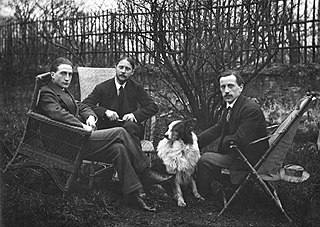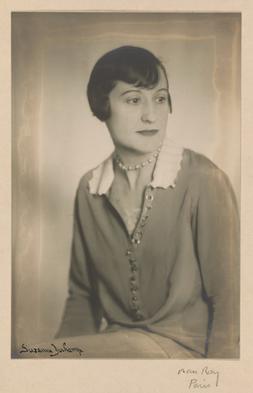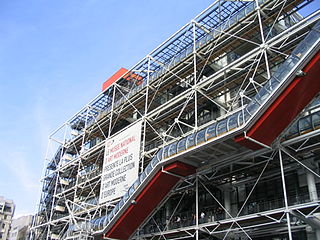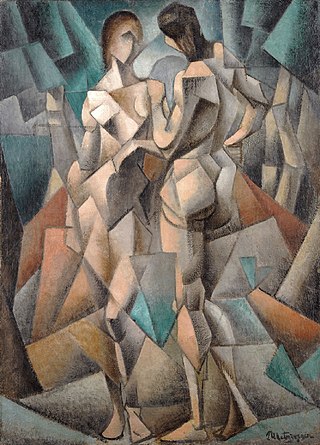
Dada or Dadaism was an art movement of the European avant-garde in the early 20th century, with early centres in Zürich, Switzerland, at the Cabaret Voltaire, founded by Hugo Ball with his companion Emmy Hennings, and in Berlin in 1917. New York Dada began c. 1915, and after 1920 Dada flourished in Paris. Dadaist activities lasted until the mid 1920s.

Henri-Robert-Marcel Duchamp was a French painter, sculptor, chess player, and writer whose work is associated with Cubism, Dada, and conceptual art. He is commonly regarded, along with Pablo Picasso and Henri Matisse, as one of the three artists who helped to define the revolutionary developments in the plastic arts in the opening decades of the 20th century, responsible for significant developments in painting and sculpture. He has had an immense impact on 20th- and 21st-century art, and a seminal influence on the development of conceptual art. By the time of World War I, he had rejected the work of many of his fellow artists as "retinal", intended only to please the eye. Instead, he wanted to use art to serve the mind.

Guillaume Apollinaire was a French poet, playwright, short story writer, novelist and art critic of Polish descent.

Francis Picabia was a French avant-garde painter, writer, filmmaker, magazine publisher, poet, and typographist closely associated with Dada.

Jacques Villon, also known as Gaston Duchamp, was a French Cubist and abstract painter and printmaker.

Suzanne Duchamp-Crotti was a French Dadaist painter, collagist, sculptor, and draughtsman. Her work was significant to the development of Paris Dada and modernism and her drawings and collages explore fascinating gender dynamics. Due to the fact that she was a woman in the male prominent Dada movement, she was rarely considered an artist in her own right. She constantly lived in the shadows of her famous older brothers, who were also artists, or she was referred to as "the wife of." Her work in painting turns out to be significantly influential to the landscape of Dada in Paris and to the interests of women in Dada. She took a large role as an avant-garde artist, working through a career that spanned five decades, during a turbulent time of great societal change. She used her work to express certain subject matter such as personal concerns about modern society, her role as a modern woman artist, and the effects of the First World War. Her work often weaves painting, collage, and language together in complex ways.

The Musée National d'Art Moderne is the national museum for modern art of France. It is located in Paris and is housed in the Centre Pompidou in the 4th arrondissement of the city. In 2021 it ranked 10th in the list of most visited art museums in the world, with 1,501,040 visitors. It is one of the largest museums for modern and contemporary art.

The Section d'Or, also known as Groupe de Puteaux or Puteaux Group, was a collective of painters, sculptors, poets and critics associated with Cubism and Orphism. Based in the Parisian suburbs, the group held regular meetings at the home of the Duchamp brothers in Puteaux and at the studio of Albert Gleizes in Courbevoie. Active from 1911 to around 1914, members of the collective came to prominence in the wake of their controversial showing at the Salon des Indépendants in the spring of 1911. This showing by Albert Gleizes, Jean Metzinger, Robert Delaunay, Henri le Fauconnier, Fernand Léger and Marie Laurencin, created a scandal that brought Cubism to the attention of the general public for the first time.

L.H.O.O.Q. is a work of art by Marcel Duchamp. First conceived in 1919, the work is one of what Duchamp referred to as readymades, or more specifically a rectified ready-made. The readymade involves taking mundane, often utilitarian objects not generally considered to be art and transforming them, by adding to them, changing them, or simply renaming and reorienting them and placing them in an appropriate setting. In L.H.O.O.Q. the found object is a cheap postcard reproduction of Leonardo da Vinci's early 16th-century painting Mona Lisa onto which Duchamp drew a moustache and beard in pencil and appended the title.

New York Dada was a regionalized extension of Dada, an artistic and cultural movement between the years 1913 and 1923. Usually considered to have been instigated by Marcel Duchamp's Fountain exhibited at the first exhibition of the Society of Independent Artists in 1917, and becoming a movement at the Cabaret Voltaire in February, 1916, in Zürich, the Dadaism as a loose network of artists spread across Europe and other countries, with New York becoming the primary center of Dada in the United States. The very word Dada is notoriously difficult to define and its origins are disputed, particularly amongst the Dadaists themselves.
Leonardo da Vinci's Mona Lisa is one of the most recognizable and famous works of art in the world, and also one of the most replicated and reinterpreted. Mona Lisa replicas were already being painted during Leonardo's lifetime by his own students and contemporaries. Some are claimed to be the work of Leonardo himself, and remain disputed by scholars. Prominent 20th-century artists such as Marcel Duchamp and Salvador Dalí have also produced derivative works, manipulating Mona Lisa's image to suit their own aesthetic. Replicating Renaissance masterpieces continues to be a way for aspiring artists to perfect their painting techniques and prove their skills.

The Société Normande de Peinture Moderne, also known as Société de Peinture Moderne, or alternatively, Normand Society of Modern Painting, was a collective of eminent painters, sculptors, poets, musicians and critics associated with Post-Impressionism, Fauvism, Cubism and Orphism. The Société Normande de la Peinture Moderne was a diverse collection of avant-garde artists; in part a subgrouping of the Cubist movement, evolving alongside the so-called Salon Cubist group, first independently then in tandem with the core group of Cubists that emerged at the Salon d'Automne and Salon des Indépendants between 1909 and 1911. Historically, the two groups merged in 1912, at the Section d'Or exhibition, but documents from the period prior to 1912 indicate the merging occurred earlier and in a more convoluted manner.

Didier Ottinger, born in Nancy in 1957, is a French museum curator, art critic and author. He is known for organizing exhibitions and publishing books on modern and contemporary painting. He is now assistant director of the Centre Pompidou at the Musée national d'art moderne in Paris.

Les Peintres Cubistes, Méditations Esthétiques, is a book written by Guillaume Apollinaire between 1905 and 1912, published in 1913. This was the third major text on Cubism; following Du "Cubisme" by Albert Gleizes and Jean Metzinger (1912); and André Salmon, Histoire anecdotique du cubisme (1912).

Gabrièle Buffet-Picabia was a French art critic and writer affiliated with Dadaism. She was an organiser of the French resistance and the first wife of artist Francis Picabia.

Galeries Dalmau was an art gallery in Barcelona, Spain, from 1906 to 1930. The gallery was founded and managed by the Symbolist painter and restorer Josep Dalmau i Rafel. The aim was to promote, import and export avant-garde artistic talent. Dalmau is credited for having launched avant-garde art in Spain.

Caoutchouc is a painting created circa 1909 by the French artist Francis Picabia. At the crossroads of Cubism and Fauvism, Caoutchouc is considered one of the first abstract works in Western painting. The painting is in the collection of Centre Pompidou, Musée National d'Art Moderne, in Paris.

Udnie, also known as Udnie , is an oil on canvas painting by French artist Francis Picabia, executed in 1913. It is held at the Musée National d'Art Moderne, Centre Georges Pompidou, in Paris.

Animal Trainer is a enamel on canvas painting by the French painter Francis Picabia, created in 1923. It is held at the Musée National d'Art Moderne, in Paris.


















